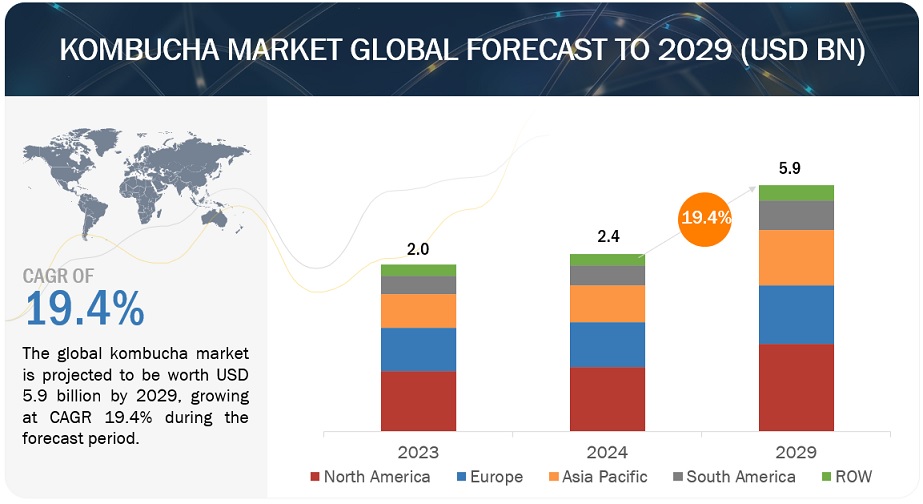According to MarketsandMarkets, the kombucha market is projected to reach USD 5.9 billion by 2029 from USD 2.4 billion by 2024, at a CAGR of 19.4% during the forecast period in terms of value. The trend towards organic and natural products has propelled the popularity of kombucha, as it is often made with organic ingredients and is seen as a healthier alternative to sugary sodas and artificial drinks. The availability of a wide range of flavors and variations has also contributed to market growth, appealing to diverse consumer preferences.

Download PDF Brochure: https://www.marketsandmarkets.com/pdfdownloadNew.asp?id=211406364
By nature, the organic segment is expected to hold a significant market share in the kombucha market.
The organic type of kombucha is experiencing significant growth due to several key reasons. Firstly, there is a growing consumer preference for organic products driven by concerns about health, sustainability, and environmental impact. the organic certification of kombucha provides a level of transparency and credibility that enhances consumer trust and confidence in the product’s integrity and authenticity. Another driving factor behind the growth of organic kombucha is the expansion of distribution channels and increased availability in retail outlets, health food stores, and online platforms. As consumer demand for organic products continues to rise, retailers are responding by offering a wider selection of organic beverages, including kombucha, thereby expanding market reach and accessibility.
By distribution channels, the supermarkets/hypermarkets segment holds the highest market share in the kombucha market.
Supermarkets and Hypermarkets is essential for distributing kombucha products to consumers. These large retail outlets offer a wide variety of kombucha brands and flavors to cater to diverse preferences. They provide ample shelf space, ensuring visibility for kombucha products and encouraging impulse buys. Moreover, supermarkets and hypermarkets frequently offer promotions and discounts on kombucha items, further motivating consumer purchases. With their extensive presence in both urban and suburban areas, these establishments serve as convenient points of purchase for consumers, significantly contributing to the accessibility and popularity of kombucha products. In summary, the supermarkets/hypermarkets segment acts as a primary distribution channel for kombucha, fostering market penetration and fueling the growth of the kombucha market.
North America to dominate the kombucha market during the forecast period.
North America’s dominance in the kombucha market can be attributed to several key factors. The region’s early embrace of health-conscious trends, particularly in the United States, has fostered a culture receptive to alternative wellness products like kombucha. Furthermore, North American consumers’ increasing awareness of the beverage’s perceived health benefits and probiotic content has driven significant demand. Additionally, the widespread accessibility of kombucha products through various distribution channels, coupled with a relatively favorable regulatory environment, further bolsters market expansion.
Make an Inquiry: https://www.marketsandmarkets.com/Enquiry_Before_BuyingNew.asp?id=211406364
Key Market Players
The key players in this market include GT’s Living Foods (US), Brew Dr. (US), SYSTM Foods Inc. (US), Health-Ade LLC (US), Tropicana Brands Group (US), MOMO Kombucha (UK), GO Kombucha (UK), Harris Freeman (US), Kosmic Kombucha (US), Equinox Kombucha (UK), Remedy Drinks (Australia), Soulfresh Global Pty Ltd (Australia), Cruz Group Sp. z o. o. (Poland), NessAlla Kombucha (US), and FedUp Foods (US). These market participants are emphasizing the expansion of their footprint via agreements and partnerships. They maintain a robust presence in North America, Asia Pacific, South America, RoW, and Europe, and they are supported by manufacturing facilities and well-established distribution networks spanning these regions.